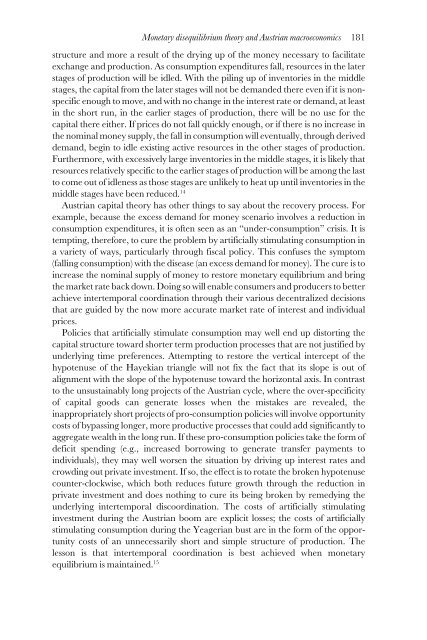Money and Markets: Essays in Honor of Leland B. Yeager
Money and Markets: Essays in Honor of Leland B. Yeager
Money and Markets: Essays in Honor of Leland B. Yeager
You also want an ePaper? Increase the reach of your titles
YUMPU automatically turns print PDFs into web optimized ePapers that Google loves.
Monetary disequilibrium theory <strong>and</strong> Austrian macroeconomics 181structure <strong>and</strong> more a result <strong>of</strong> the dry<strong>in</strong>g up <strong>of</strong> the money necessary to facilitateexchange <strong>and</strong> production. As consumption expenditures fall, resources <strong>in</strong> the laterstages <strong>of</strong> production will be idled. With the pil<strong>in</strong>g up <strong>of</strong> <strong>in</strong>ventories <strong>in</strong> the middlestages, the capital from the later stages will not be dem<strong>and</strong>ed there even if it is nonspecificenough to move, <strong>and</strong> with no change <strong>in</strong> the <strong>in</strong>terest rate or dem<strong>and</strong>, at least<strong>in</strong> the short run, <strong>in</strong> the earlier stages <strong>of</strong> production, there will be no use for thecapital there either. If prices do not fall quickly enough, or if there is no <strong>in</strong>crease <strong>in</strong>the nom<strong>in</strong>al money supply, the fall <strong>in</strong> consumption will eventually, through deriveddem<strong>and</strong>, beg<strong>in</strong> to idle exist<strong>in</strong>g active resources <strong>in</strong> the other stages <strong>of</strong> production.Furthermore, with excessively large <strong>in</strong>ventories <strong>in</strong> the middle stages, it is likely thatresources relatively specific to the earlier stages <strong>of</strong> production will be among the lastto come out <strong>of</strong> idleness as those stages are unlikely to heat up until <strong>in</strong>ventories <strong>in</strong> themiddle stages have been reduced. 14Austrian capital theory has other th<strong>in</strong>gs to say about the recovery process. Forexample, because the excess dem<strong>and</strong> for money scenario <strong>in</strong>volves a reduction <strong>in</strong>consumption expenditures, it is <strong>of</strong>ten seen as an “under-consumption” crisis. It istempt<strong>in</strong>g, therefore, to cure the problem by artificially stimulat<strong>in</strong>g consumption <strong>in</strong>a variety <strong>of</strong> ways, particularly through fiscal policy. This confuses the symptom(fall<strong>in</strong>g consumption) with the disease (an excess dem<strong>and</strong> for money). The cure is to<strong>in</strong>crease the nom<strong>in</strong>al supply <strong>of</strong> money to restore monetary equilibrium <strong>and</strong> br<strong>in</strong>gthe market rate back down. Do<strong>in</strong>g so will enable consumers <strong>and</strong> producers to betterachieve <strong>in</strong>tertemporal coord<strong>in</strong>ation through their various decentralized decisionsthat are guided by the now more accurate market rate <strong>of</strong> <strong>in</strong>terest <strong>and</strong> <strong>in</strong>dividualprices.Policies that artificially stimulate consumption may well end up distort<strong>in</strong>g thecapital structure toward shorter term production processes that are not justified byunderly<strong>in</strong>g time preferences. Attempt<strong>in</strong>g to restore the vertical <strong>in</strong>tercept <strong>of</strong> thehypotenuse <strong>of</strong> the Hayekian triangle will not fix the fact that its slope is out <strong>of</strong>alignment with the slope <strong>of</strong> the hypotenuse toward the horizontal axis. In contrastto the unsusta<strong>in</strong>ably long projects <strong>of</strong> the Austrian cycle, where the over-specificity<strong>of</strong> capital goods can generate losses when the mistakes are revealed, the<strong>in</strong>appropriately short projects <strong>of</strong> pro-consumption policies will <strong>in</strong>volve opportunitycosts <strong>of</strong> bypass<strong>in</strong>g longer, more productive processes that could add significantly toaggregate wealth <strong>in</strong> the long run. If these pro-consumption policies take the form <strong>of</strong>deficit spend<strong>in</strong>g (e.g., <strong>in</strong>creased borrow<strong>in</strong>g to generate transfer payments to<strong>in</strong>dividuals), they may well worsen the situation by driv<strong>in</strong>g up <strong>in</strong>terest rates <strong>and</strong>crowd<strong>in</strong>g out private <strong>in</strong>vestment. If so, the effect is to rotate the broken hypotenusecounter-clockwise, which both reduces future growth through the reduction <strong>in</strong>private <strong>in</strong>vestment <strong>and</strong> does noth<strong>in</strong>g to cure its be<strong>in</strong>g broken by remedy<strong>in</strong>g theunderly<strong>in</strong>g <strong>in</strong>tertemporal discoord<strong>in</strong>ation. The costs <strong>of</strong> artificially stimulat<strong>in</strong>g<strong>in</strong>vestment dur<strong>in</strong>g the Austrian boom are explicit losses; the costs <strong>of</strong> artificiallystimulat<strong>in</strong>g consumption dur<strong>in</strong>g the <strong>Yeager</strong>ian bust are <strong>in</strong> the form <strong>of</strong> the opportunitycosts <strong>of</strong> an unnecessarily short <strong>and</strong> simple structure <strong>of</strong> production. Thelesson is that <strong>in</strong>tertemporal coord<strong>in</strong>ation is best achieved when monetaryequilibrium is ma<strong>in</strong>ta<strong>in</strong>ed. 15
















